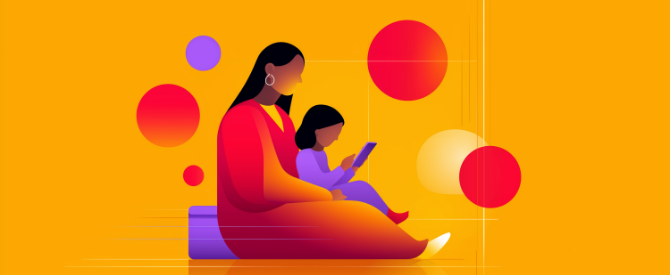
By Thabo Peyi
May 27th, 2025
7 min read
Talk TikTok to Me: Cracking New-Age Slang

Gone are the days of “dig it”, “threads”, and “gnarly” – say hello to “rizz”, “aura”, and “GRWM”. What was once considered a cool way to express oneself a few years ago is now seen as the complete opposite by today’s youth. Gen Z is shaping culture and determining what counts as “cool slang”.
But if you’re a millennial or a Gen-X and often feel like you’re hearing a foreign language when young people speak, or reading complete gibberish – fear not. We’ve got you covered with all the latest slang, whether you want to tease your kids, relate to younger family members, or you’re just a concerned adult wanting to keep your children safe online.
Related
Categories
All
Entertainment
Self Help
Tech News
Company Updates
Community
Social Media
New-age slang leaders
Before we get into the current wave of slang, it’s important to understand where it originates from. With the evolution of social media over time and the rise of more real-life video content, where people can authentically be themselves, as seen on TikTok, Reels, and even streaming platforms like Twitch – these platforms have become breeding grounds for new slang.
Streaming creator groups such as AMP and FaZe Clan have positioned themselves at the forefront of shaping both culture and slang.

The Current Wave of Slang
Rizz: Taken from the word charisma, rizz refers to someone’s ability to flirt or attract people they’re interested in.
“Andile’s got rizz – they can pull anyone they want at the party.”
Aura: This refers to someone’s overall, effortless coolness or “swag” – essentially, how they carry themselves around others.
“Lamine Yamal’s got so much aura.”
GRWM: An abbreviation for Get Ready With Me, popularised on TikTok as a genre of fashion or lifestyle video. It involves someone filming themselves getting ready – whether that’s getting dressed to go out, doing their makeup, or even preparing for bed.
Sus: Short for suspicious, this term became mainstream through the popular game Among Us.
“Why are you acting sus?”
No cap: This means no lie or I’m being serious. You can say someone is “capping” if you think they’re lying.
“No cap, bro – last night was so much fun.”
Serving: Used when someone is coming across as confident, or if something about their appearance looks great – like their outfit, makeup, or hair.
“Yes! Her outfit is serving today.”
Finsta: Short for fake Instagram account. This is a secondary Instagram account someone creates to post more candid, unfiltered, or chaotic content that they wouldn’t share on their main profile.
Ate that: Means you’ve done something impressive or cool.
“Your speech in front of the school? Yeah, you ate that.”
Huzz: This is a term used to refer to someone who is attractive. A variation of this is ‘Chuzz,’ where the ‘C’ stands for ‘chopped,’ referring to a woman who is considered unattractive.
Delulu: Derived from delusional. It refers to someone being overly optimistic or having unrealistic expectations, often about something unlikely to happen.
“She’s being delulu if she thinks he’s going to text back.”
Down bad: This term is used when someone is going through a difficult or challenging time. It could be anything from a breakup, losing a job, or being in a tough financial situation.
“You can’t be this down bad.”
Understanding all the new-age slang can be difficult to grasp and navigate these days, as it is constantly evolving. However, keeping up with it shouldn’t be a challenge. With apps like the BARK Parental Control app readily available, staying up to date with the latest slang – while also protecting your child’s online presence – is made simple.
If you’re looking for a deeper dive into current slang terms in the hope of safeguarding your child’s online safety, look no further than BARK’s article on this very topic. BARK is a parental control software that helps you monitor and protect your child’s digital life.
BARK sends you notifications if your child is being bullied online, and it allows you to block access to certain websites and apps – giving you peace of mind that they aren’t browsing content they shouldn’t be. BARK also lets you set screen time limits to help prevent endless scrolling and reduce the risk of phone addiction and so much more.
Get RSAWEB Fibre today and get a BARK Junior Parental Control App subscription for free, valued at R1200. Protect your child’s online activity.

What the emoji?
Just when you think slang can’t get any trickier to understand, along come the emojis. Emojis are another form of communication that has taken the way young people talk by storm. Oftentimes, people can have a full conversation using just emojis. So, decoding what emojis mean is crucial to understanding what kids are saying, as well as the manner in which they are doing so.
Here is a breakdown of popular emojis:
💀 Skull: This emoji means “I’m dead” in a playful way, usually referring to laughing really hard.
Example: “That’s so funny 💀”
🧍♂️ Standing Person: This emoji can have multiple meanings, such as feeling awkward, stunned, or emotionally frozen.
Example: “How I felt when they were arguing in class 🧍♂️”
🫡 Salute Face: This emoji is often used to show agreement or affirmation, but can also be used sarcastically.
Example: “I appreciate the birthday wish 🫡”
😭 Loudly Crying Face: This emoji can express many things depending on context – something hilarious, overwhelming, or sad.
Example: “She just messaged me 😭”
🧢 Cap: As mentioned earlier, “cap” means a lie, and this emoji represents that slang.
Example: “I don’t believe you 🧢”
💅 Nail Polish: This emoji represents sassiness or cockiness.
Example: “You know I had to put her in her place, real quick 💅”
👉👈 Pointing Fingers: These emojis are often used to express shyness or awkwardness, usually in a playful way when asking for something.
Example: “Can you please buy me a packet of chips at break 👉👈”
😤🔥 Face with Steam & Fire: This combo is used to hype someone up or to compliment them.
Example: “Your Instagram post was nice 😤🔥”
🫠 Melting Face: This emoji can express embarrassment or second-hand cringe.
Example: “I can’t believe I stuttered in front of the whole class during my presentation 🫠”
🍆 Eggplant: While it’s a vegetable, this emoji is often playfully used in texting to represent something cheeky or suggestive.
Example: “What are you doing this weekend? 🍆” (used in a flirty or teasing way)
🍑 Peach: This emoji is often used playfully to represent a person’s backside in a lighthearted or cheeky way.
Example: “That gym photo of yours was great 🍑”
Understanding slang and emojis is essential for safeguarding your child’s online safety. At RSAWEB, we’re more than just an internet service provider – we’re committed to equipping parents with the knowledge and tools to better protect their children online and to enhance the wellbeing and lifestyle of everyone connected with us.
Latest Blogs
School holidays are coming! Learn how to manage your child’s…
Connecting South Africans to fast, affordable, and reliable fibre is…
Talk TikTok to Me: Cracking New-Age Lingo

Thabo Peyi
27th May, 2025
7 min read

Gone are the days of “dig it”, “threads”, and “gnarly” – say hello to “rizz”, “aura”, and “GRWM”. What was once considered a cool way to express oneself a few years ago is now seen as the complete opposite by today’s youth. Gen Z is shaping culture and determining what counts as “cool slang”.
But if you’re a millennial or a Gen-X and often feel like you’re hearing a foreign language when young people speak, or reading complete gibberish – fear not. We’ve got you covered with all the latest slang, whether you want to tease your kids, relate to younger family members, or you’re just a concerned adult wanting to keep your children safe online.
New-age slang leaders
Before we get into the current wave of slang, it’s important to understand where it originates from. With the evolution of social media over time and the rise of more real-life video content, where people can authentically be themselves, as seen on TikTok, Reels, and even streaming platforms like Twitch – these platforms have become breeding grounds for new slang.
Streaming creator groups such as AMP and FaZe Clan have positioned themselves at the forefront of shaping both culture and slang.

The Current Wave of Slang
Rizz: Taken from the word charisma, rizz refers to someone’s ability to flirt or attract people they’re interested in.
“Andile’s got rizz – they can pull anyone they want at the party.”
Aura: This refers to someone’s overall, effortless coolness or “swag” – essentially, how they carry themselves around others.
“Lamine Yamal’s got so much aura.”
GRWM: An abbreviation for Get Ready With Me, popularised on TikTok as a genre of fashion or lifestyle video. It involves someone filming themselves getting ready – whether that’s getting dressed to go out, doing their makeup, or even preparing for bed.
Sus: Short for suspicious, this term became mainstream through the popular game Among Us.
“Why are you acting sus?”
No cap: This means no lie or I’m being serious. You can say someone is “capping” if you think they’re lying.
“No cap, bro – last night was so much fun.”
Serving: Used when someone is coming across as confident, or if something about their appearance looks great – like their outfit, makeup, or hair.
“Yes! Her outfit is serving today.”
Finsta: Short for fake Instagram account. This is a secondary Instagram account someone creates to post more candid, unfiltered, or chaotic content that they wouldn’t share on their main profile.
Ate that: Means you’ve done something impressive or cool.
“Your speech in front of the school? Yeah, you ate that.”
Huzz: This is a term used to refer to someone who is attractive. A variation of this is ‘Chuzz,’ where the ‘C’ stands for ‘chopped,’ referring to a woman who is considered unattractive.
Delulu: Derived from delusional. It refers to someone being overly optimistic or having unrealistic expectations, often about something unlikely to happen.
“She’s being delulu if she thinks he’s going to text back.”
Down bad: This term is used when someone is going through a difficult or challenging time. It could be anything from a breakup, losing a job, or being in a tough financial situation.
“You can’t be this down bad.”
Understanding all the new-age slang can be difficult to grasp and navigate these days, as it is constantly evolving. However, keeping up with it shouldn’t be a challenge. With apps like the BARK Parental Control app readily available, staying up to date with the latest slang – while also protecting your child’s online presence – is made simple.
If you’re looking for a deeper dive into current slang terms in the hope of safeguarding your child’s online safety, look no further than BARK’s article on this very topic. BARK is a parental control software that helps you monitor and protect your child’s digital life.
BARK sends you notifications if your child is being bullied online, and it allows you to block access to certain websites and apps – giving you peace of mind that they aren’t browsing content they shouldn’t be. BARK also lets you set screen time limits to help prevent endless scrolling and reduce the risk of phone addiction and so much more.
Get RSAWEB Fibre today and get a BARK Junior Parental Control App subscription for free, valued at R1200. Protect your child’s online activity.

What the emoji?
Just when you think slang can’t get any trickier to understand, along come the emojis. Emojis are another form of communication that has taken the way young people talk by storm. Oftentimes, people can have a full conversation using just emojis. So, decoding what emojis mean is crucial to understanding what kids are saying, as well as the manner in which they are doing so.
Here is a breakdown of popular emojis:
💀 Skull: This emoji means “I’m dead” in a playful way, usually referring to laughing really hard.
Example: “That’s so funny 💀”
🧍♂️ Standing Person: This emoji can have multiple meanings, such as feeling awkward, stunned, or emotionally frozen.
Example: “How I felt when they were arguing in class 🧍♂️”
🫡 Salute Face: This emoji is often used to show agreement or affirmation, but can also be used sarcastically.
Example: “I appreciate the birthday wish 🫡”
😭 Loudly Crying Face: This emoji can express many things depending on context – something hilarious, overwhelming, or sad.
Example: “She just messaged me 😭”
🧢 Cap: As mentioned earlier, “cap” means a lie, and this emoji represents that slang.
Example: “I don’t believe you 🧢”
💅 Nail Polish: This emoji represents sassiness or cockiness.
Example: “You know I had to put her in her place, real quick 💅”
👉👈 Pointing Fingers: These emojis are often used to express shyness or awkwardness, usually in a playful way when asking for something.
Example: “Can you please buy me a packet of chips at break 👉👈”
😤🔥 Face with Steam & Fire: This combo is used to hype someone up or to compliment them.
Example: “Your Instagram post was nice 😤🔥”
🫠 Melting Face: This emoji can express embarrassment or second-hand cringe.
Example: “I can’t believe I stuttered in front of the whole class during my presentation 🫠”
🍆 Eggplant: While it’s a vegetable, this emoji is often playfully used in texting to represent something cheeky or suggestive.
Example: “What are you doing this weekend? 🍆” (used in a flirty or teasing way)
🍑 Peach: This emoji is often used playfully to represent a person’s backside in a lighthearted or cheeky way.
Example: “That gym photo of yours was great 🍑”
Understanding slang and emojis is essential for safeguarding your child’s online safety. At RSAWEB, we’re more than just an internet service provider – we’re committed to equipping parents with the knowledge and tools to better protect their children online and to enhance the wellbeing and lifestyle of everyone connected with us.











